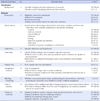Abstract
Purpose
This study was done to evaluate quality of reports of non-randomized controlled quasi-experimental study articles published in the Korean Journal of Women Health Nursing (KJWHN).
Methods
A search was done for experimental studies assessing intervention effects among all articles published in the KJWHNfrom 2008 to 2013. Original articles were reviewed and analyzed according to the 22 checklist items of the guidelines for Transparent Reporting for Evaluations with Non-randomized Designs (TREND).
Results
Thirty-five articles on experimental studies were identified. The evaluation of the quality of reporting in these experimental studies found that there was a wide variety in the level of satisfying the TREND checklist. In particular, according to TREND topics, low levels of reporting quality were found for "title & abstract (only for information on how units were allocated to the intervention)", "outcomes in methods", "assignment in methods", "blinding in methods", "recruitment in results", "baseline data in results", "interpretation in discussion (especially intervention mechanism and success or barriers), "generalizability in discussion".
Figures and Tables
References
1. Centers for Disease Control and Prevention. TREND supporters. 2011. Retrieved October 13, 2013. from http://www.cdc.gov/trendstatement/supporters.html.
2. Des Jarlais DC, Lyles C, Crepaz N. the TREND Group. Improving the reporting quality of nonrandomized evaluations of behavioral and public health interventions: The TERND statement. Am J Public Health. 2004; 94:361–366.
3. Hwang YW, Lee KW, Hwang IH, Kim SY. The quality of reporting of randomized controlled trials in Korean medical journals indexed in KoreaMed: Survey of items of the revised CONSORT statement. J Korean Acad Fam Med. 2008; 29:276–282.
4. Jüni P, Altman DG, Egger M. Systematic reviews in healthcare: Assessing the quality of controlled clinical trials. BMJ. 2001; 323:42–46.
5. Kim HJ, Kim SY. Quality assessment of non-randomized studies in the Korean Jou rnal of Family Medicine. Korean J Fam Med. 2009; 30:129–137. http://dx.doi.org/10.4082/kjfm.2009.30.2.129.
6. Kim KH, Kim JH, Lim KC, Lee KS, Jeong JS, Choe MA, et al. Quality assessment tools and reporting standards in nursing research. J Korean Biol Nurs Sci. 2012; 14:221–230. http://dx.doi.org/10.7586/jkbns.2012.14.3.221.

7. Lachin JM. Statistical considerations in the intent-totreat principle. Control Clin Trials. 2000; 21:167–189.

8. Moher D, Hopewell S, Schulz KF, Montori V, Gotzsche PC, Devereaux PJ, et al. CONSORT 2010 explanation and elaboration: Updated guidelines for reporting parallel group randomized trials. Int J Surg. 2012; 10:28–55. http://dx.doi.org/10.1016/j.ijsu.2011.10.001.
9. Riethmuller AM, Jones R, Okely AD. Efficacy of interventions to improve motor development in young children: A systematic review. Pediatrics. 2009; 124:e782–e792. http://dx.doi.org/10.1542/peds.2009-0333.

10. Rothwell PM. External validity of randomized controlled trials: "to whom do the results of this trial apply?". Lancet. 2005; 365:82–93.
11. Shin CM, Han CS, Pae CU, Patkar AA. Tools for quality evaluation of clinical research reports. Korean J Psychopharmacol. 2011; 22:67–72.
12. Vandenbroucke JP, von Elm E, Altman DG, Gotzsche PC, Mulrow CD, Pocock SJ, et al. Strengthening the reporting of observational studies in epidemiology (STROBE): Explanation and elaboration. Epidemiology. 2007; 18:805–835.
13. Walker W. The strengths and weaknesses of research designs involving quantitative measures. J Res Nurs. 2005; 10:571–582.

14. Wood L, Egger M, Gluud LL, Schulz KF, Juni P, Altman DG, et al. Empirical evidence of bias in treatment effect estimates in controlled trials with different interventions and outcomes: Meta-epidemiological study. BMJ. 2008; 336:601–605. http://dx.doi.org/10.1136/bmj.39465.451748.AD.

15. Yoo SH. Reporting guidelines for health promotion research. J Korean Soc Health Educ Promot. 2012; 29:83–99.




 PDF
PDF ePub
ePub Citation
Citation Print
Print







 XML Download
XML Download